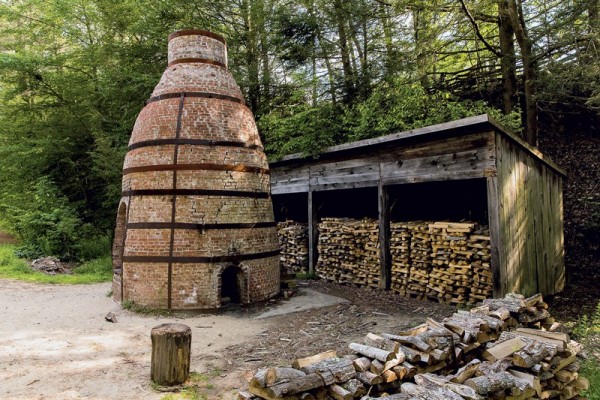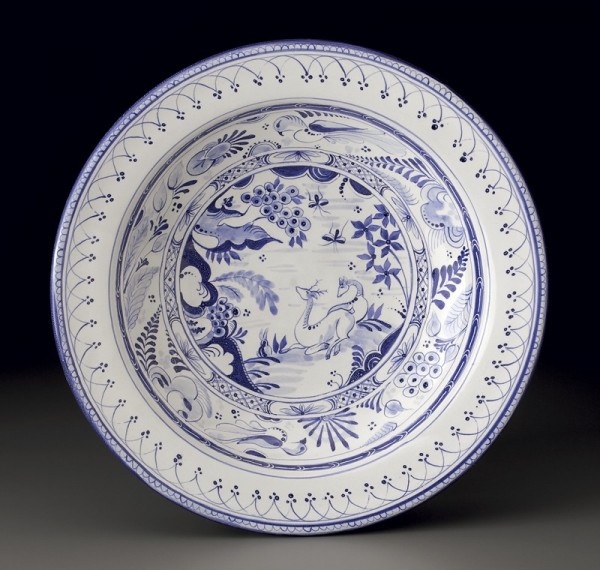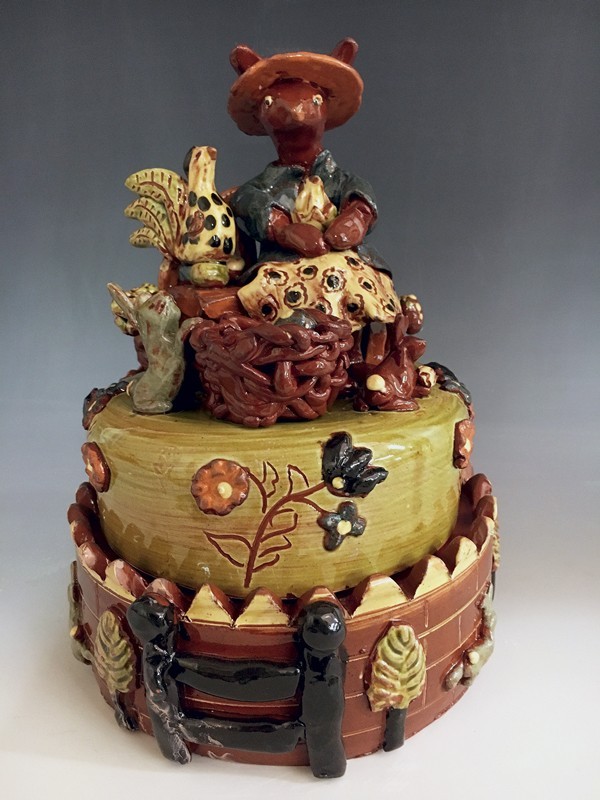
Workspace of Stephen Earp, Shelburne Falls, Massachusetts, 2017. (Photo, Stephen Earp.)

Lidded jar, Stephen Earp, Shelburne Falls, Massachusetts, 2012. Earthenware. H. 12". (Photo, John Polak.) The early-nineteenth-century redware of Connecticut and Long Island has inspired much of my redware production.

Hervey Brooks kiln at Old Sturbridge Village, Sturbridge, Massachusetts. (Courtesy, Old Sturbridge Village.)

Joe Jostes demonstrating at the Colonial Market & Fair, George Washington’s Mt. Vernon, 2016. (Photo, Stephen Earp.)

A collection of ovoid black-glazed jugs, American, ca. 1820–1830. Earthenware. (Private collection; photo, Gridley + Graves Photographers.)

Dish, attributed to the Smith Pottery, Norwalk, Connecticut, ca. 1840. Slip-decorated earthenware. D. 13". (Courtesy, Norwalk Historical Society).

Dish, workshop of the Albright/Loy pottery, Alamance County, North Carolina, ca. 1800. Slip-decorated earthenware. D. 15 1/4". (Courtesy, Old Salem Museum and Gardens.)

Plate, Stephen Earp, Shelburne Falls, Massachusetts, 2011. Sgraffitto-decorated earthenware. D. 11". (Photo, John Polak.)

Pitcher, Ken Henderson, Bangor, Maine, 2006. Earthenware. H. 7". (Author’s collection; photo Stephen Earp.)

Charger, Joe Jostes, Salesville, Arkansas, 2016. Earthenware with cabled slip design detail. D. 13". (Courtesy, S&J Pottery.)

“Water under the Bridge” vase, Ephraim Pottery, Lake Mills, Wisconsin, 2009. Earthenware. H. 12 1/2". (Courtesy, Ephraim Pottery.) The formal naturalism and technical explorations of the Art Pottery movement continue to inspire potters today, as we see here.

Moravian-style slipware dishes, Tammy Zettlemoyer, Fort Frederick Eighteenth Century Market Fair, Fort Frederick State Park, Big Pool, Maryland, 2017. (Courtesy, Tammy Zettlemoyer.)

Ned Foltz with sculptural redware, Reinholds, Pennsylvania, 2016. (Courtesy, Sam Shoemaker.)

Face jug, Wesley Muckey, Mohnton, Pennsylvania, 2016. Earthenware. H. 14". (Courtesy, Nolde Forest Pottery.)

Lidded jar, Greg Shooner, Oregonia, Ohio, 2016. Earthenware. H. 14". (Courtesy, Shooner Redware.)

Mary Farrell demonstrates making an Alamance County, North Carolina, slipware bowl of the type illustrated in fig. 17.

Bowl, Alamance County, North Carolina, 1790-1820. Lead-glazed earthenware. H. 3". (Private collection.)

Costrel, Rick Hamelin and Garine Arakelian, Warren, Massachusetts, 2014. Earthenware. H. 6 3/4". (Courtesy, Rick Hamelin.)

English-style slipware charger, Ron Geering, Falmouth, Massachusetts, 2014. Earthenware. D. 13". (Courtesy, Ron Geering.)

Dish, Stephen Earp, Shelburne Falls, Massachusetts, 2016. Tin-glazed earthenware. D. 13". (Photo, John Polak.) A similar pair of reclining deer on a plate in the Abby Aldrich Rockefeller Folk Art Museum of Colonial Williamsburg provided a prompt to explore compositions incorporating various animal and floral combinations.

Lidded mocha jar, Joe Jostes, Salesville, Arkansas, 2016. Earthenware. H. 10". (Courtesy, S&J Pottery.)

The Shooner wood-fired kiln in action. (Courtesy, Greg Shooner.)

Greg Shooner in his studio, 2017.

Dish, Stephen Earp, Shelburne Falls, Massachusetts, 2017. Tin-glazed earthenware. D. 14". (Photo, John Polak.) In the delft style, the dish is inscribed “No handicraft can with our art compare, we make our pots of what we potters are.”

Plate, Don Carpentier, Eastfield Village, East Nassau, New York, 2010. Earthenware. D. 9". (Author’s collection, photo, John Pollak.) A circa 1760–style Staffordshire “tortoise-shell” pierced-and-glazed creamware plate.

Ceramic artist Eleanor Pugh demonstrating techniques of North Carolina slip decorating at Eastfield Village, East Nassau, New York, 2017. (Photo, Robert Hunter.)

Michelle Erickson demonstrating slip decorating of an early-eighteenth-century-style Staffordshire slipware cup. (Courtesy, Ceramics in America.)

America and Susquehannock, Michelle Erickson, Hampton, Virginia, 2017. Creamware. H. 29 1/2". (Private collection; photo, Robert Hunter.) Michelle Erickson was commissioned to design and create this pair of ceramic artworks. Based on eighteenth-century English cockle pots, these large-scale examples incorporate iconography inspired by a private collection of period prints, maps, and American furniture.

Lidded redware jar, Sue Skinner, Salesville, Arkansas, 2016. Earthenware. H. 9". (Courtesy, S&J Pottery.)

Tall sgraffito form, Ron Geering, Falmouth, Massachusetts, 2016. Earthenware. H. 17". (Coutesy, Ron Geering.)

Flower pots, Guy Wolff, Litchfield, Connecticut, 2018. Earthenware. (Photo, Visko Hatfield.)
